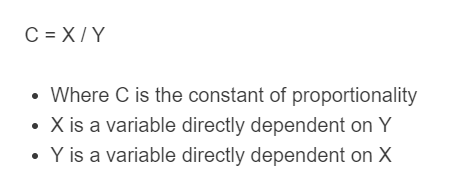Enter two dependent variables into the calculator to determine the constant of proportionality.
- Direct Variation Calculator
- Unit Rate Calculator
- Proportion Calculator
- Coefficient of Variation Calculator
- Relative Change Calculator
Constant of Proportionality Formula
The following formula is used to calculate a constant of proportionality.
C = Y/X
- Where C is the constant of proportionality
- X is a variable directly dependent on Y
- Y is a variable directly dependent on X
Constant of Proportionality Definition
The constant of proportionality is a fundamental mathematical concept that measures the relationship between two variables. It represents the fixed ratio by which the values of one variable change about the values of another variable.
It is denoted by the letter ‘k’ and is derived from the equation y = kx, where y and x are variables that are directly proportional to each other.
In simpler terms, the constant of proportionality determines how one variable scales in response to changes in another variable.
For example, if two variables are directly proportional, an increase in one variable will result in a proportional increase in the other variable by a fixed amount. This fixed amount is precisely the constant of proportionality.
Understanding the constant of proportionality is crucial in numerous areas of mathematics and real-life applications. It allows us to analyze and predict the behavior of variables in various situations. By knowing the constant of proportionality, we can accurately determine how changes in one variable will affect the other variable.
Constant of Proportionality Example
How to calculate the constant of proportionality?
Example #1:
In this example, the variables are inversely proportional. Let’s say we have X which we know is 5, and we have the constant of proportionality of 2. We can then find Y by rearranging the equation Y = X*C = 5*2 = 10.
The constant of proportionality can be used to calculate the missing variable.
Example #2:
In this example, we are going to calculate the constant of proportionality instead of using it to find a missing variable.
The values of x and y are given as 15 and 5 respectively. Using the formula above, the Constant of Proportionality is calculated to be C = Y/X = 5/15 = .333.
Now we want to calculate a new variable from this constant. We are given a variable Y of 10. To calculate the missing variable X, we re-arrange the equation to X=Y/C = 10/.333 = 30.33.
8 Things to Know About Constant of Proportionality
1. Is the constant of proportionality the same as a slope?
The terms slope and constant of proportionality are often used interchangeably. A typical linear equation is presented in the form y=a*x + b. In those cases, the variable a is considered the same as the constant of proportionality.
2. Is the constant of proportionality the same as the unit rate?
A unit rate is defined as a rate with a denominator of one. Since the constant of proportionality is used interchangeably with slope, it can also be used interchangeably with the unit rate in most cases.
This is because a slope is defined as the change in a variable Y with respect to X when X is simplified to 1.
3. Is the constant of proportionality a fraction?
The constant of proportionality is often displayed as a simplified fraction with a denominator of 1. For example, if we have values of Y=10 and X=5, the simplified fraction would be 10/5 = 2/1 = 2. In this example, the COP could be left as 10/5, which is, of course, a fraction, but simplifying the fraction to 2/1 simplifies further calculations using that COP.
4. Can the constant of proportionality be negative?
Whenever one of either of Y or X or negative, but not both, the constant of proportionality will also be negative. This is the same case as with a slope, which is clear if you have an understanding of basic graphs and linear lines.
5. Does a constant of proportionality have units?
The COP can have units if the problem or use requires it. For example, let’s say we are looking at a problem in which Y represents a weight, and X represents speed. In this scenario, Y would have units of kg or lbs and X would have units of m/s or ft/s. The subsequent units for the constant of proportionality would then be kg/(m/s).
Another example of this would be if Y represents force, and X represents mass. The units for Y would be Newtons (N) and the units for X would be kilograms (kg). This would yield units of Newtons per kilogram, N/kg, for the constant of proportionality.
6. Can the constant of proportionality be a decimal?
A constant of proportionality can be a fraction, and as a result, can be represented as a decimal, just like all fractions can.
For example, let’s say we have Y and X values of 1 and 2 respectively. This would yield a COP of 1/2. 1/2 can then be simplified to the decimal 0.5.
7. What is the constant of proprotionality on a graph?
On a graph, the constant of proportionality can be found by calculating the slope of the line on the graph. For example, if you have a line with the form y=2*x, the COP would be 2.
8. How to find constant of proportionality on a table?
Most tables are represented as individual cells with values when X and Y equal certain values. When these cells are equal to Y/X, the constant of proportionality is the value in that cell.

